Conserving Ecosystem Diversity in the Tropical Andes
Abstract
:1. Introduction
2. Materials and Methods
2.1. Study Area
2.2. GEOBON User Needs Assessment
2.3. Targeted Ecosystems
2.4. Measuring Long-Term Type Loss from Land Conversion
2.5. Ecosystem Type Representation in Protected Areas (IUCN I-VI)
2.6. Additional Ecosystem Representation in Key Biodiversity Areas
2.7. Utilizing Multiple Levels of the IVC Classification Hierarchy
3. Results
3.1. Long-Term Loss in Extent—Vegetation Macrogroups of the Tropical Andes
3.2. Macrogroup Representation in Protected Areas
3.3. Additional Macrogroup Representation in Key Biodiversity Areas
3.4. Utilizing the IVC Classification Hierarchy for EBV Roll-Up
3.5. Utilizing the IVC for EBV Step-Down for Local Uses
4. Discussion
4.1. Applying the IVC Classification Hierarchy from Local to Global Scales
4.2. Lesson Learned from the EBVs Workshop
5. Conclusions
Supplementary Materials
Author Contributions
Funding
Data Availability Statement
Acknowledgments
Conflicts of Interest
References
- Myers, N.; Mittermeier, R.A.; Mittermeier, C.G.; Da Fonseca, G.A.; Kent, J. Biodiversity hotspots for conservation priorities. Nature 2000, 403, 853. [Google Scholar] [CrossRef] [PubMed]
- Anderson, E.P.; Marengo, J.; Villalba, R.; Halloy, S.; Young, B.; Cordero, D.; Gast, F.; Jaimes, E.; Ruiz, D. Consequences of climate change for ecosystems and ecosystem services in the tropical Andes. In Climate Change and Biodiversity in the Tropical Andes; Inter-American Institute for Global Change Research (IAI) and Scientific Committee on Problems of the Environment (SCOPE): Montevideo, Uruguay, 2011; pp. 1–18. [Google Scholar]
- Josse, C.; Cuesta, F.; Navarro, G.; Barrena, V.; Becerra, M.T.; Cabrera, E.; Chacón-Moreno, E.; Ferreira, W.; Peralvo, M.; Saito, J. Physical geography and ecosystems in the tropical Andes. In Climate Change and Biodiversity in the Tropical Andes; Herzog, S.K., Martínez, R., Jørgensen, P.M., Tiessen, H., Eds.; Inter-American Institute for Global Change Research (IAI) and Scientific Committee on Problems of the Environment (SCOPE): Montevideo, Uruguay, 2011; pp. 152–169. [Google Scholar]
- Mittermeier, R.; Mittermeier, C.; Gil, P. Megadiversity: Earth’s biologically wealthiest nations. Chelonian Conserv. Biol. 1999, 3, 537. [Google Scholar]
- Jetz, W.; Wilcove, D.S.; Dobson, A.P. Projected impacts of climate and land-use change on the global diversity of birds. PLoS Biol. 2007, 5, e157. [Google Scholar] [CrossRef] [PubMed] [Green Version]
- Wassenaar, T.; Gerber, P.; Verburg, P.H.; Rosales, M.; Ibrahim, M.; Steinfeld, H. Projecting land use changes in the Neotropics: The geography of pasture expansion into forest. Glob. Environ. Chang. 2007, 17, 86–104. [Google Scholar] [CrossRef]
- Jarvis, A.; Touval, J.L.; Schmitz, M.C.; Sotomayor, L.; Hyman, G.G. Assessment of threats to ecosystems in South America. J. Nat. Conserv. 2010, 18, 180–188. [Google Scholar] [CrossRef]
- Armenteras, D.; Rodríguez, N.; Retana, J.; Morales, M. Understanding deforestation in montane and lowland forests of the Colombian Andes. Reg. Environ. Chang. 2011, 11, 693–705. [Google Scholar] [CrossRef]
- Rodríguez, E.; Armenteras-Pascual, D.; Alumbreros, J. Land use and land cover change in the Colombian Andes: Dynamics and future scenarios. J. Land Use Sci. 2013, 8, 154–174. [Google Scholar] [CrossRef]
- Brooks, T.M.; Mittermeier, R.A.; da Fonseca, G.A.; Gerlach, J.; Hoffmann, M.; Lamoreux, J.F.; Mittermeier, C.G.; Pilgrim, J.D.; Rodrigues, A.S. Global biodiversity conservation priorities. Science 2006, 313, 58–61. [Google Scholar] [CrossRef] [Green Version]
- Malcolm, J.R.; Liu, C.; Neilson, R.P.; Hansen, L.; Hannah, L. Global warming and extinctions of endemic species from biodiversity hotspots. Conserv. Biol. 2006, 20, 538–548. [Google Scholar] [CrossRef]
- Beaumont, L.J.; Pitman, A.; Perkins, S.; Zimmermann, N.E.; Yoccoz, N.G.; Thuiller, W. Impacts of climate change on the world’s most exceptional ecoregions. Proc. Natl. Acad. Sci. USA 2011, 108, 2306–2311. [Google Scholar] [CrossRef] [Green Version]
- Ramirez-Villegas, J.; Cuesta, F.; Devenish, C.; Peralvo, M.; Jarvis, A.; Arnillas, C.A. Using species distributions models for designing conservation strategies of Tropical Andean biodiversity under climate change. J. Nat. Conserv. 2014, 22, 391–404. [Google Scholar] [CrossRef] [Green Version]
- Mittermeier, R.A.; Turner, W.R.; Larsen, F.W.; Brooks, T.M.; Gascon, C. Global biodiversity conservation: The critical role of hotspots. In Biodiversity Hotspots; Springer: Berlin/Heidelberg, Germany, 2011; pp. 3–22. [Google Scholar]
- Hoffmann, D.; Oetting, I.; Arnillas, A.; Ulloa, R. Climate change and protected areas in the tropical Andes. In Climate Change and Biodiversity in the Tropical Andes; Inter-American Institute for Global Change Research (IAI) and Scientific Committee on Problems of the Environment (SCOPE): Montevideo, Uruguay, 2011; pp. 311–325. [Google Scholar]
- Bax, V.; Francesconi, W. Conservation gaps and priorities in the Tropical Andes biodiversity hotspot: Implications for the expansion of protected areas. J. Environ. Manag. 2019, 232, 387–396. [Google Scholar] [CrossRef] [PubMed]
- Sarkar, S.; Sánchez-Cordero, V.; Londoño, M.C.; Fuller, T. Systematic conservation assessment for the Mesoamerica, Chocó, and Tropical Andes biodiversity hotspots: A preliminary analysis. Biodivers. Conserv. 2009, 18, 1793–1828. [Google Scholar] [CrossRef]
- Lessmann, J.; Munoz, J.; Bonaccorso, E. Maximizing species conservation in continental Ecuador: A case of systematic conservation planning for biodiverse regions. Ecol. Evol. 2014, 4, 2410–2422. [Google Scholar] [CrossRef] [PubMed]
- Rosenzweig, M.L. Species Diversity in Space and Time; No. 574.524 R6; Cambridge University Press: Cambridge, UK, 1995. [Google Scholar]
- Lockwood, J.L.; Powell, R.D.; Nott, M.P.; Pimm, S.L. Assembling ecological communities in time and space. Oikos 1997, 80, 549–553. [Google Scholar] [CrossRef]
- Convention on Biological Diversity (CBD). A New Global Framework for Managing Nature through 2030. 2021. Available online: https://www.cbd.int/doc/c/914a/eca3/24ad42235033f031badf61b1/wg2020-03-03-en.pdf (accessed on 15 January 2022).
- Visconti, P.; Butchart, S.H.; Brooks, T.M.; Langhammer, P.F.; Marnewick, D.; Vergara, S.; Yanosky, A.; Watson, J.E. Protected area targets post-2020. Science 2019, 364, 239–241. [Google Scholar] [CrossRef] [Green Version]
- Visconti, P.; Butchart, S.H.; Brooks, T.M.; Langhammer, P.F.; Marnewick, D.; Vergara, S.; Yanosky, A.; Watson, J.E. Essential biodiversity variables. Science 2013, 339, 277–278. [Google Scholar]
- Navarro, L.M.; Fernández, N.; Guerra, C.; Guralnick, R.; Kissling, W.D.; Londoño, M.C.; Muller-Karger, F.; Turak, E.; Balvanera, P.; Costello, M.J.; et al. Monitoring biodiversity change through effective global coordination. Curr. Opin. Environ. Sustain. 2017, 29, 158–169. [Google Scholar] [CrossRef]
- Comer, P.J.; Hak, J.C.; Josse, C.; Smyth, R. Long-term loss in extent and current protection of terrestrial ecosystem diversity in the temperate and tropical Americas. PLoS ONE 2020, 15, e0234960. [Google Scholar] [CrossRef]
- Comer, P.J.; Hak, J.C.; Dockter, D.; Smith, J. Integration of vegetation classification with land cover mapping: Lessons from regional mapping efforts in the Americas. Veg. Classif. Surv. 2022, 3, 29–43. [Google Scholar] [CrossRef]
- Faber-Langendoen, D.; Baldwin, K.; Peet, R.K.; Meidinger, D.; Muldavin, E.; Keeler-Wolf, T.; Josse, C. The EcoVeg approach in the Americas: US, Canadian and international vegetation classifications. Phytocoenologia 2018, 48, 215–237. [Google Scholar] [CrossRef]
- Chen, J.; Cao, X.; Peng, S.; Ren, H. Analysis and applications of GlobeLand30: A review. ISPRS Int. J. Geo-Inf. 2007, 6, 230. [Google Scholar] [CrossRef] [Green Version]
- Dudley, N.; Phillips, A. Forests and Protected Areas: Guidance on the Use of the IUCN Protected Area Management Categories; IUCN: Gland, Switzerland, 2006. [Google Scholar]
- Josse, C.; Navarro, G.; Comer, P.; Evans, R.; Faber-Langendoen, D.; Fellows, M.; Kittel, G.; Menard, S.; Pyne, M.; Reid, M.; et al. Ecological Systems of Latin America and the Caribbean: A Working Classification of Terrestrial Systems; NatureServe: Arlington, VA, USA, 2003. [Google Scholar]
- Josse, C.; Navarro, G.; Encarnación, F.; Tovar, A.; Comer, P.; Ferreira, W.; Rodríguez, F.; Saito, J.; Sanjurjo, J.; Ruben de Celis, E.; et al. Sistemas Ecológicos de la Cuenca Amazónica de Perú y Bolivia: Clasificación y Mapeo; NatureServe: Arlington, VA, USA, 2007; 96p. [Google Scholar]
- Sarmiento, L.; Llambí, L.D.; Escalona, A.; Marquez, N. Vegetation patterns, regeneration rates and divergence in an old-field succession of the high tropical Andes. Plant Ecol. 2003, 166, 145–156. [Google Scholar] [CrossRef]
- Swenson, J.W.; Young, B.E.; Beck, S.; Comer, P.J.; Cordova, J.; Embert, D.; Encarnación, F.; Ferreira, W.; Franke, I.; Grossman, D.; et al. Plant and Animal Endemism in the Eastern Andean Slope: Challenges to Conservation. BMC Ecol. 2012, 12, 1. [Google Scholar] [CrossRef] [Green Version]
- Lippok, D.; Beck, S.G.; Renison, D.; Gallegos, S.C.; Saavedra, F.V.; Hensen, I.; Schleuning, M. Forest recovery of areas deforested by fire increases with elevation in the tropical Andes. For. Ecol. Manag. 2013, 295, 69–76. [Google Scholar] [CrossRef]
- IDEAM. Leyenda Nacional de Coberturas de la Tierra. Metodología CORINE Land Cover Adaptada para Colombia Escala 1:100.000; Instituto de Hidrología, Meteorología y Estudios Ambientales: Bogotá, Colombia, 2010; 72p. [Google Scholar]
- Ferrer-Paris, J.R.; Zager, I.; Keith, D.A.; Oliveira-Miranda, M.A.; Rodríguez, J.P.; Josse, C.; González-Gil, M.; Miller, R.M.; Zambrana-Torrelio, C.; Barrow, E. An ecosystem risk assessment of temperate and tropical forests of the Americas with an outlook on future conservation strategies. Conserv. Lett. 2019, 12, e12623. [Google Scholar] [CrossRef]
- Comer, P.J.; Hak, J.C.; Seddon, E. Documenting at-risk status of terrestrial ecosystems in temperate and tropical North America. Conserv. Sci. Pract. 2022, 4, e603. [Google Scholar] [CrossRef]
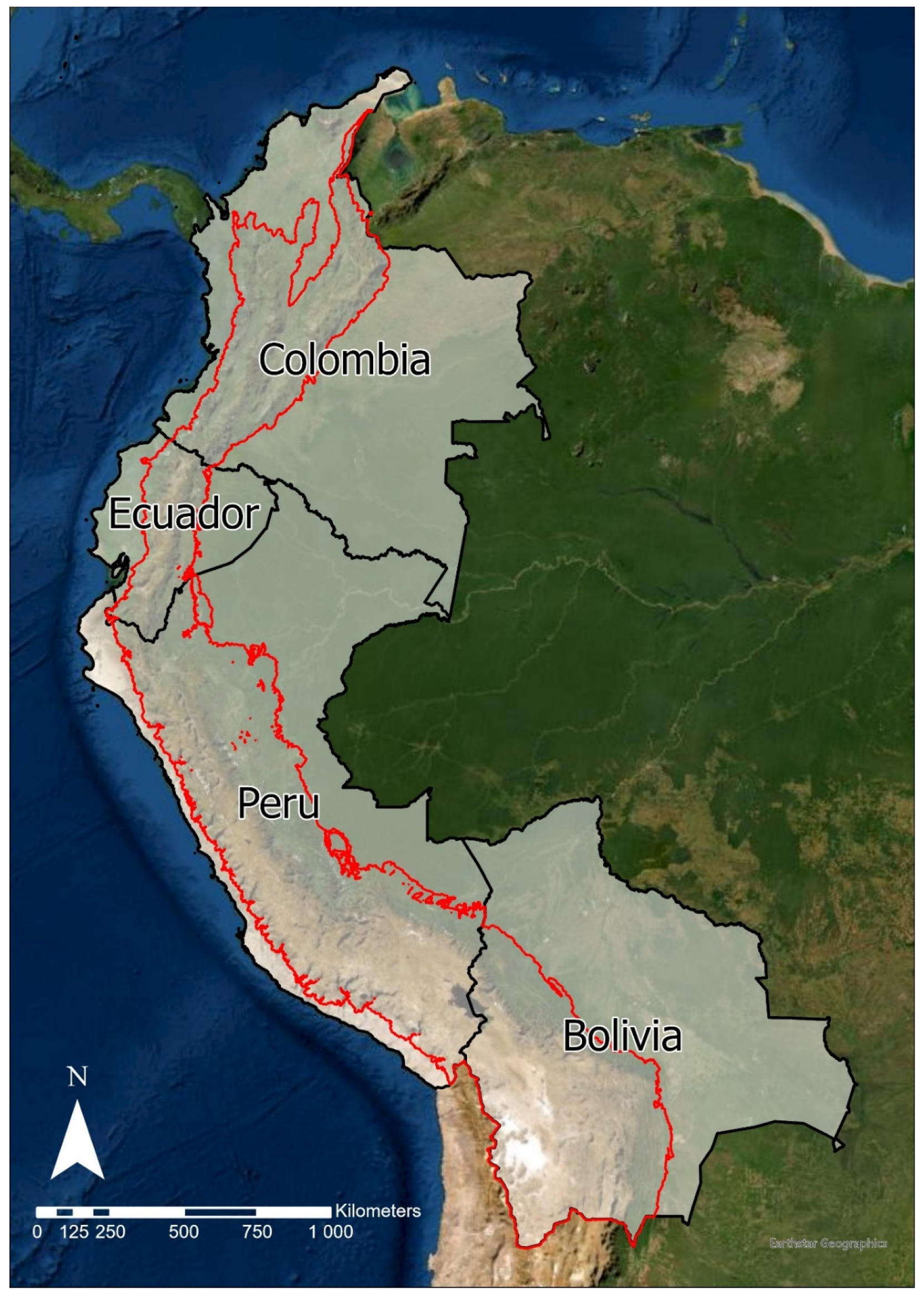

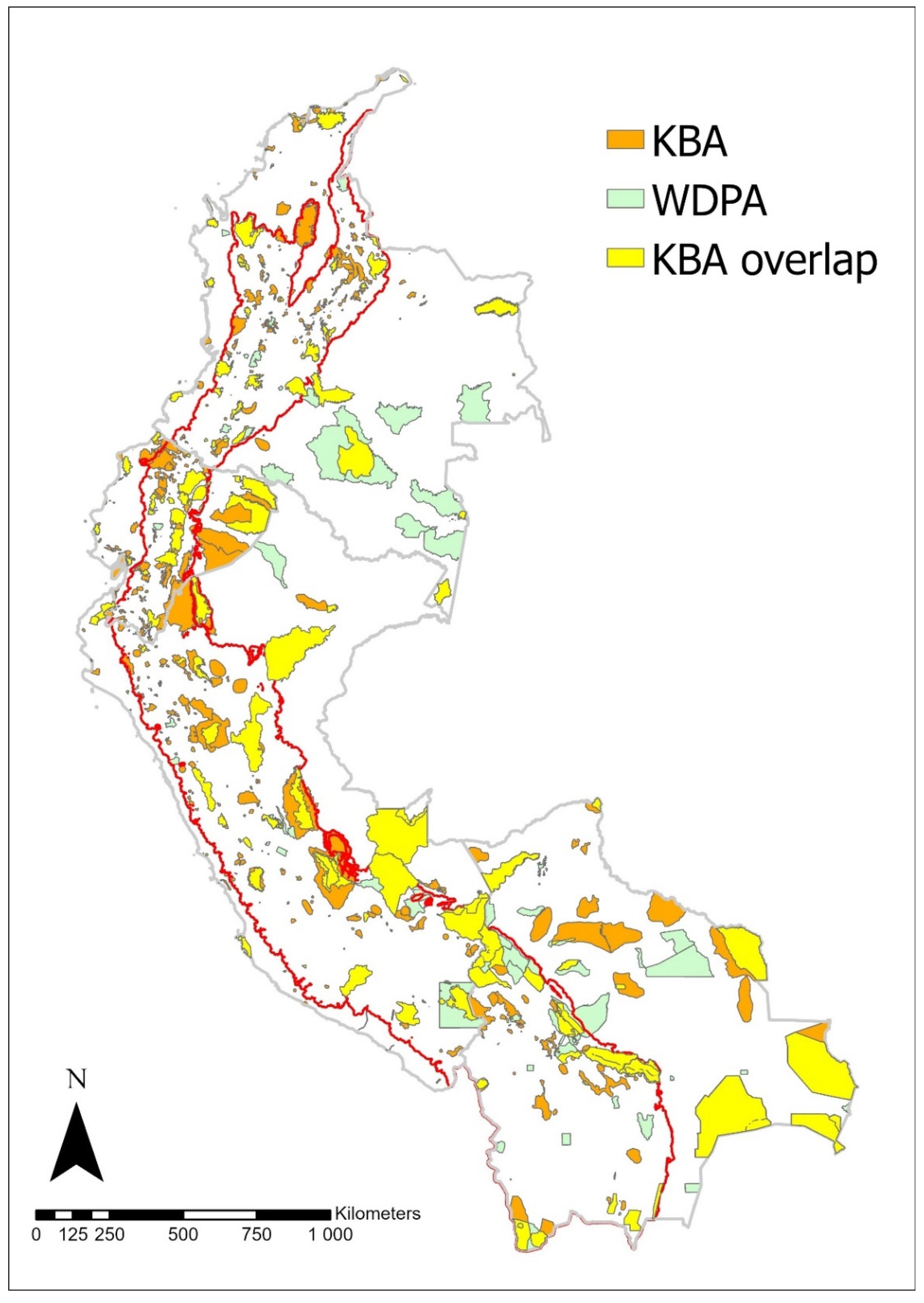

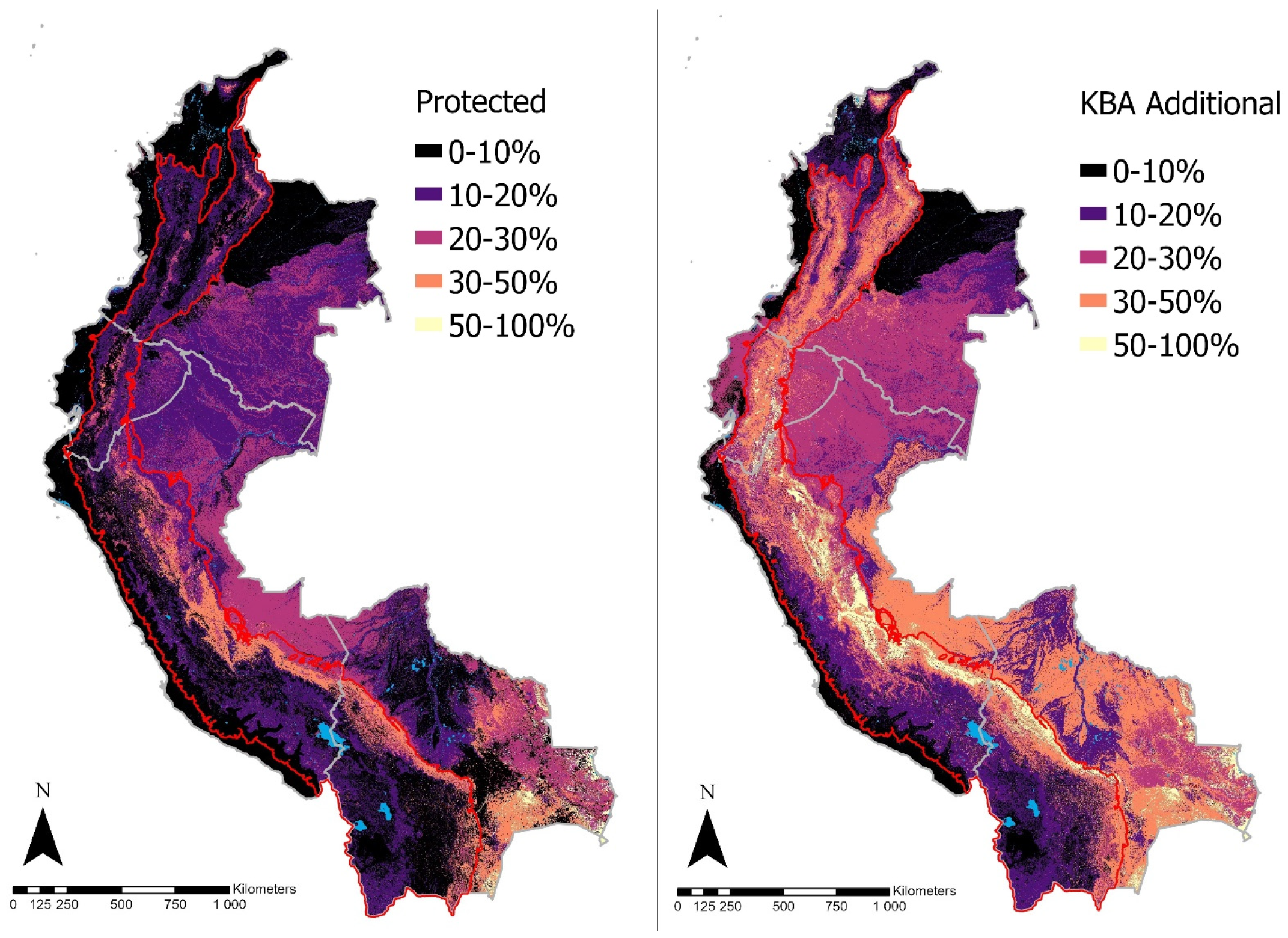
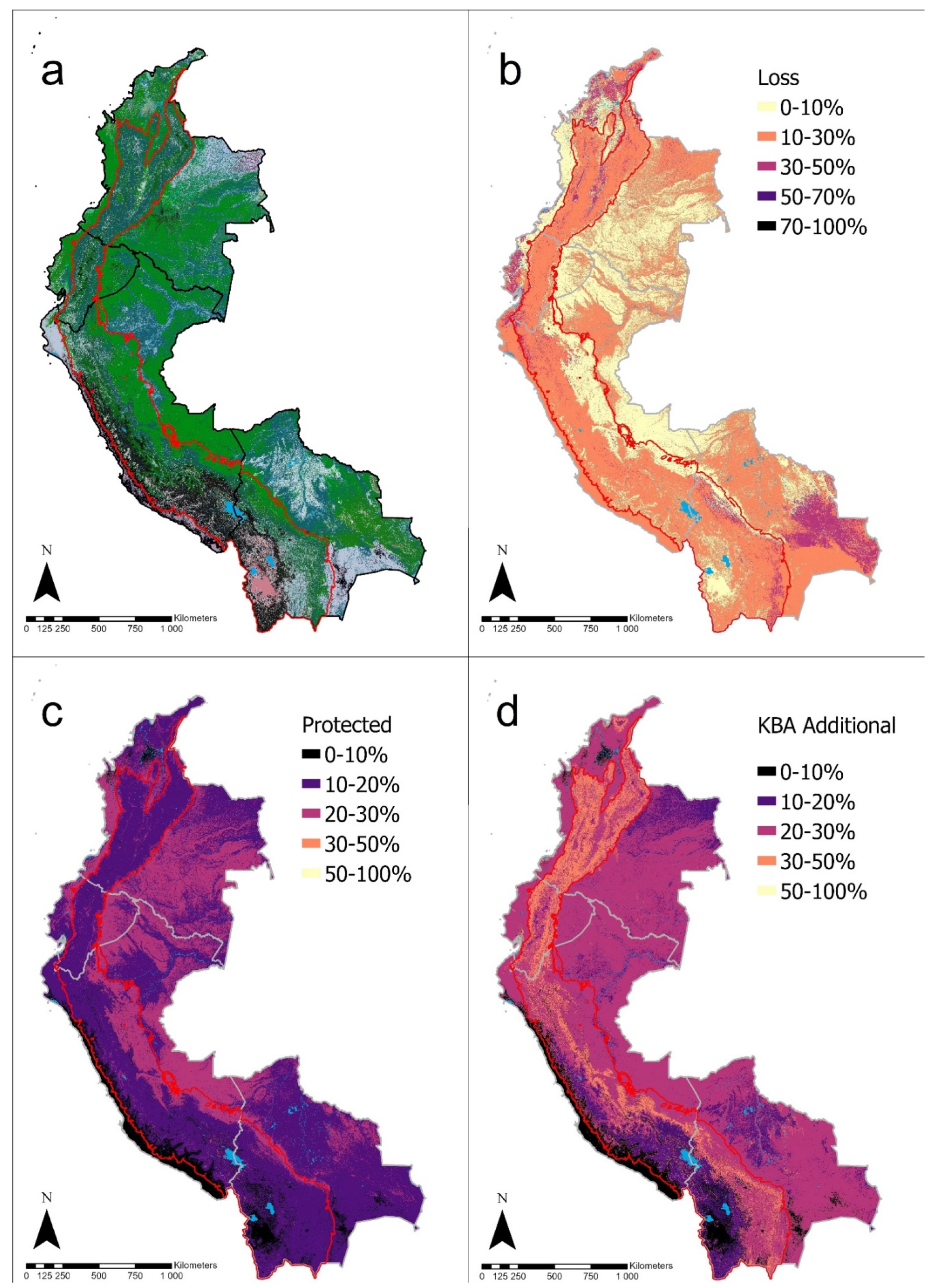
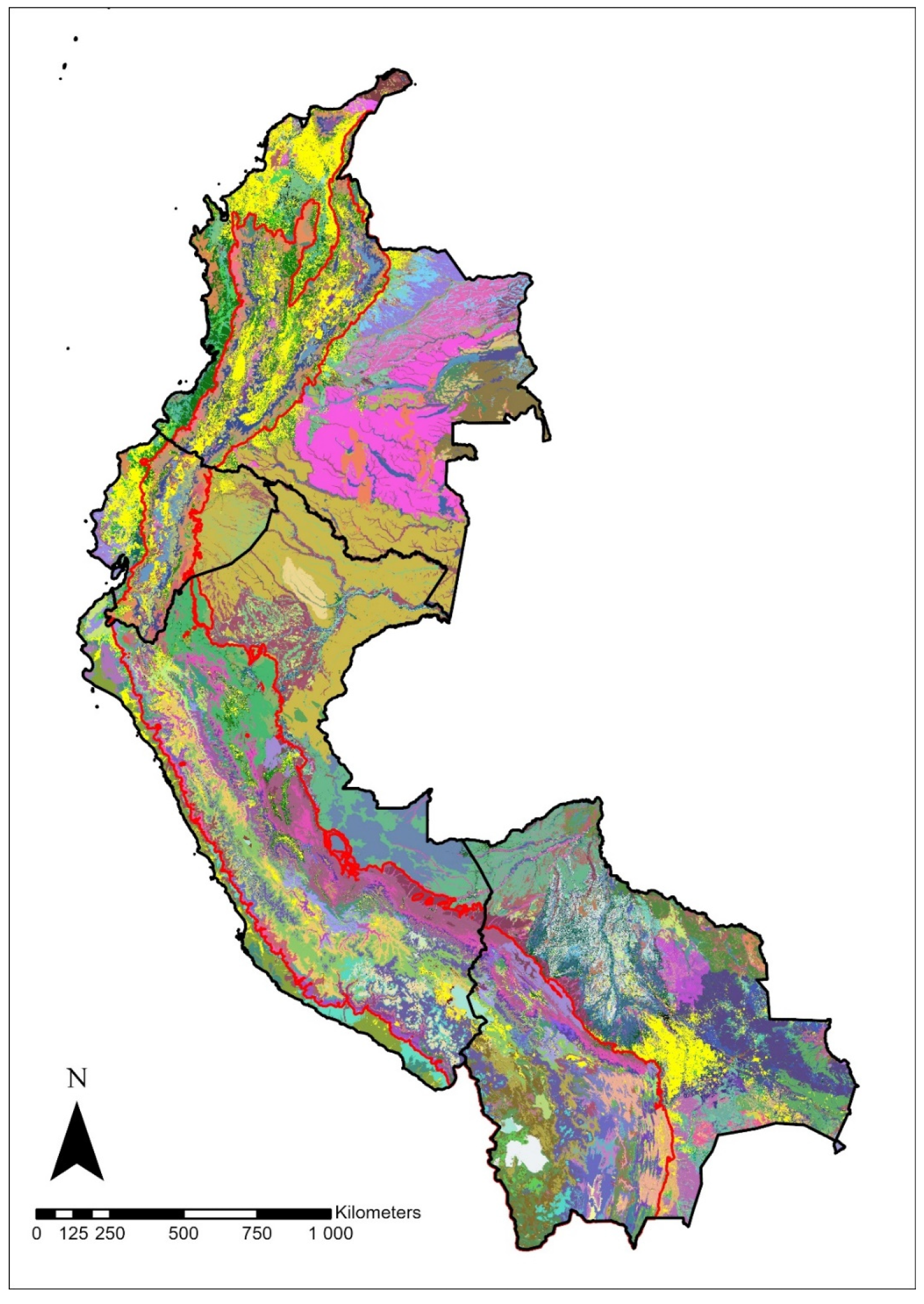
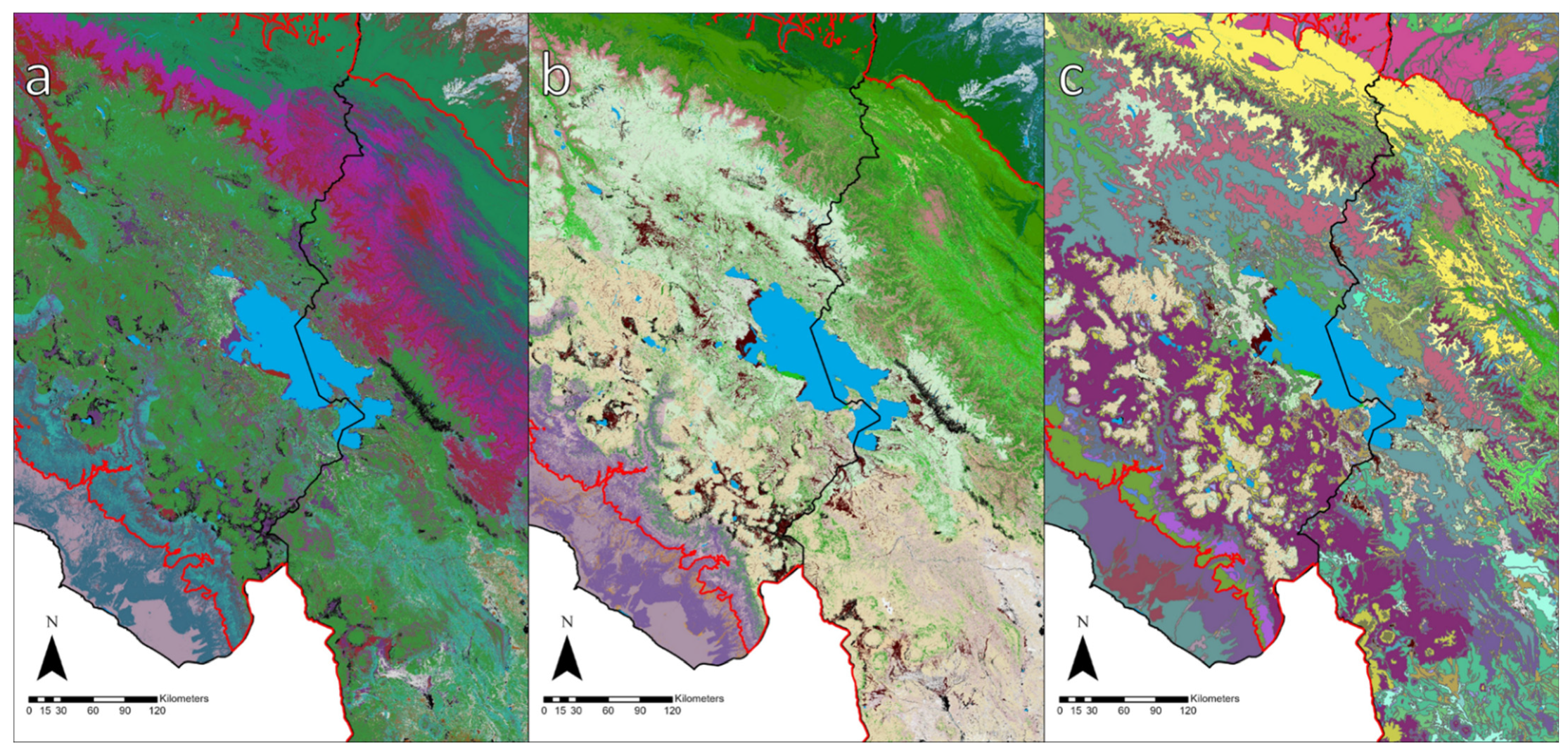
| Level No. | Level Name | Defining Characteristics | No. Types | Example (Name) |
|---|---|---|---|---|
| 1 | Class | Life Form Physiognomy | 6 | Forest and Woodland |
| 2 | Subclass | Global Physiognomy | 13 | Tropical Forest and Woodland |
| 3 | Formation | Global Physiognomy | 32 | Tropical Montane Humid Forest |
| 4 | Division | Continental Floristics | 98 | Tropical Andean Montane Humid Forest |
| 5 | Macrogroup | Subcontinental Floristics | 274 | Northern Andean Montane and Upper Montane Humid Forest |
| 6 | Group | Regional Floristics | 814 * | Bosques Altimontanos Norte-Andinos de Polylepis |
| 7 | Alliance | Local Physiognomy and Floristics | * | * |
| 8 | Association | Local Floristics | * | * |
| IVC Macrogroup | Bolivia % Loss | Bolivia % hotspot Loss | Colombia % Loss | Colombia % Hotspot Loss | Ecuador % Loss | Ecuador % hotspot Loss | Peru % Loss | Peru % Hotspot Loss |
|---|---|---|---|---|---|---|---|---|
| Chaco Riparian Marsh and Shrubland | 39.1% | 55.4% | - | - | - | - | - | - |
| Chaco Xeromorphic Cliff and Other Rock Vegetation | 7.8% | 83.0% | - | - | - | - | - | - |
| Chaco-Espinal Brackish Marsh | 43.9% | 73.3% | - | - | - | - | - | - |
| Choco-Darien Floodplain Forest | - | - | 18.3% | 24.3% | 32.8% | 77.2% | <0.1% | - |
| Guajiran Flooded Forest | - | - | 56.5% | 61.1% | - | - | - | - |
| Guajiran Seasonal Dry Forest | - | - | 60.3% | 46.0% | - | - | - | - |
| Guajiran Xeromorphic Scrub and Woodland | - | - | 59.6% | 79.3% | - | - | - | - |
| Guayaquil Flooded and Swamp Forest | - | - | - | - | 49.4% | 56.2% | 36.9% | - |
| Llanos Flooded and Swamp Forest | - | - | 20.7% | 61.0% | - | - | - | - |
| Mesoamerican Coastal Plain Swamp Forest | - | - | 36.9% | - | 74.0% | - | 71.4% | - |
| Mesoamerican Floodplain Forest | - | - | 52.8% | 10.0% | - | - | - | - |
| Mesoamerican Freshwater Marsh, Wet Meadow and Shrubland | - | - | 41.8% | <0.1% | 54.2% | <0.1% | - | - |
| Mesoamerican-South American Pacific Coastal Salt Marsh | - | - | 25.0% | 100.0% | 59.3% | - | 38.2% | <0.1% |
| Neotropical Floating and Submerged Freshwater Marsh | 22.9% | 42.2% | 24.4% | - | 60.4% | - | 24.3% | 39.7% |
| Orinoquian Floodplain Peat Meadow and Marsh | - | - | 13.2% | 100.0% | - | - | - | - |
| Southern Andean Montane Salt Marsh | 87.5% | 87.5% | - | - | - | - | - | - |
| Southwestern Amazon Floodplain Forest | 7.7% | 7.6% | 81.1% | - | - | - | 2.7% | 5.2% |
| Tumbes Guayaquil Seasonal Dry Forest | - | - | 15.6% | <0.1% | 57.6% | 29.5% | 14.2% | 10.7% |
| Tumbesian Xeromorphic Scrub and Woodland | - | - | <0.1% | - | 53.9% | 20.6% | 29.9% | 10.0% |
| Western Ecuadorian Humid Forest | - | - | 37.8% | 9.4% | 59.0% | 41.2% | 58.6% | - |
| IVC Formations | Boliva Loss % | Boliva Protected % | Boliva Protected with KBA % | Peru Loss % | Peru Protected % | Peru Protected with KBA % | Ecuador Loss % | Ecuador Protected % | Ecuador Protected with KBA% | Colombia Loss % | Colombia Protected % | Colombia Protected with KBA % |
|---|---|---|---|---|---|---|---|---|---|---|---|---|
| Cool Semi-Desert Scrub and Grassland | 8% | 4% | 6% | 10% | 12% | 13% | ||||||
| Mangrove | 49% | 17% | 17% | 47% | 24% | 24% | 23% | 13% | 13% | |||
| Mediterranean Scrub and Grassland | 2% | 5% | 5% | 0% | 0% | 0% | ||||||
| Salt Marsh | 9% | 2% | 3% | 19% | 9% | 10% | 59% | 7% | 7% | 37% | 5% | 5% |
| Tropical Bog and Fen | 21% | 19% | 28% | 29% | 19% | 24% | 49% | 28% | 42% | 39% | 33% | 47% |
| Tropical Cliff, Scree, and Other Rock Vegetation | 25% | 14% | 14% | 14% | 2% | 20% | 23% | 13% | 39% | 41% | 8% | 19% |
| Tropical Dry Forest and Woodland | 22% | 27% | 28% | 15% | 11% | 25% | 50% | 5% | 14% | 49% | 5% | 8% |
| Tropical Flooded and Swamp Forest | 12% | 19% | 19% | 4% | 12% | 14% | 23% | 33% | 35% | 15% | 16% | 17% |
| Tropical Freshwater Aquatic Vegetation | 23% | 15% | 15% | 24% | 1% | 3% | 60% | 3% | 3% | 24% | 14% | 14% |
| Tropical Freshwater Marsh, Wet Meadow, and Shrubland | 12% | 11% | 12% | 9% | 10% | 12% | 20% | 27% | 32% | 19% | 9% | 9% |
| Tropical High Montane Scrub and Grassland | 7% | 12% | 18% | 12% | 11% | 14% | 18% | 51% | 60% | 12% | 45% | 54% |
| Tropical Lowland Grassland, Savanna, and Shrubland | 22% | 50% | 50% | 7% | 22% | 32% | 9% | 23% | 23% | 17% | 16% | 16% |
| Tropical Lowland Humid Forest | 5% | 31% | 31% | 3% | 20% | 25% | 26% | 16% | 19% | 13% | 20% | 21% |
| Tropical Montane Grassland and Shrubland | 18% | 14% | 25% | 20% | 5% | 13% | 36% | 30% | 47% | 31% | 28% | 42% |
| Tropical Montane Humid Forest | 13% | 29% | 37% | 10% | 17% | 35% | 22% | 18% | 47% | 29% | 14% | 24% |
| Tropical Thorn Woodland | 19% | 27% | 30% | 21% | 5% | 13% | 40% | 8% | 21% | 48% | 6% | 13% |
| Warm Desert and Semi-Desert Scrub and Grassland | 34% | 21% | 22% | 10% | 3% | 5% | 39% | 2% | 39% | 46% | 5% | 15% |
Publisher’s Note: MDPI stays neutral with regard to jurisdictional claims in published maps and institutional affiliations. |
© 2022 by the authors. Licensee MDPI, Basel, Switzerland. This article is an open access article distributed under the terms and conditions of the Creative Commons Attribution (CC BY) license (https://creativecommons.org/licenses/by/4.0/).
Share and Cite
Comer, P.J.; Valdez, J.; Pereira, H.M.; Acosta-Muñoz, C.; Campos, F.; Bonet García, F.J.; Claros, X.; Castro, L.; Dallmeier, F.; Domic Rivadeneira, E.Y.; et al. Conserving Ecosystem Diversity in the Tropical Andes. Remote Sens. 2022, 14, 2847. https://doi.org/10.3390/rs14122847
Comer PJ, Valdez J, Pereira HM, Acosta-Muñoz C, Campos F, Bonet García FJ, Claros X, Castro L, Dallmeier F, Domic Rivadeneira EY, et al. Conserving Ecosystem Diversity in the Tropical Andes. Remote Sensing. 2022; 14(12):2847. https://doi.org/10.3390/rs14122847
Chicago/Turabian StyleComer, Patrick J., Jose Valdez, Henrique M. Pereira, Cristina Acosta-Muñoz, Felipe Campos, Francisco Javier Bonet García, Xavier Claros, Lucia Castro, Franciscio Dallmeier, Enrique Yure Domic Rivadeneira, and et al. 2022. "Conserving Ecosystem Diversity in the Tropical Andes" Remote Sensing 14, no. 12: 2847. https://doi.org/10.3390/rs14122847
APA StyleComer, P. J., Valdez, J., Pereira, H. M., Acosta-Muñoz, C., Campos, F., Bonet García, F. J., Claros, X., Castro, L., Dallmeier, F., Domic Rivadeneira, E. Y., Gill, M., Josse, C., Lafuente Cartagena, I., Langstroth, R., Larrea-Alcázar, D., Masur, A., Morejon Jaramillo, G., Navarro, L., Novoa, S., ... Fernandez, M. (2022). Conserving Ecosystem Diversity in the Tropical Andes. Remote Sensing, 14(12), 2847. https://doi.org/10.3390/rs14122847











